Estimated reading time 5 minutes, 35 seconds.
The Royal Canadian Air Force completed a month-long air policing mission over the skies of Iceland this week.

The first two of six CF-188 Hornets departed Keflavik Air Base near Reykjavik on Thursday for their home base of 433 Tactical Fighter Squadron (TFS) at 3 Wing Bagotville, Que., and will be joined over the weekend by the remaining four jets, followed next week by the remainder of the air task force.
The Iceland air surveillance is part of Operation Reassurance, the Canadian Armed Forces support to North Atlantic Treaty Organization (NATO) deterrence measures since 2014 in Eastern Europe and the Mediterranean. As Iceland does not have a standing military, NATO countries provide air policing on a rotating basis, patrolling the skies between Greenland, Norway and the United Kingdom for about four weeks during a four-month period.
Canada last conducted the Iceland mission in 2013, though it provided similar air policing with four Hornets over the Baltics in 2014, operating from an air base in Lithuania.
The air task force, made up of 154 personnel, mostly from 433 TFS and the Air Expeditionary Wing (AEW) at 2 Wing Bagotville, augmented by air weapons controllers from 22 Wing North Bay, Ont., began operations on May 18 after arriving in theatre a week earlier.
The mission calls for the ability to provide continuous air surveillance and interception capability in response to unidentified or uncommunicative non-NATO military aircraft that approach or enter NATO airspace without a flight plan, a similar role to the North American Aerospace Defense (NORAD) quick reaction response the squadron performs on a regular basis over Canada’s northern approaches.
“The big difference is that we operate under NATO standards and we are here purely for non-NATO military aircraft,” said LCol William “Billy” Mitchell, air task force commander and the commanding officer of 433 TFS. “Anything to do with the civilian side of the house is not within our mandate or our rules of engagement to provide a response.”
Although NATO fighter jets are scrambling more frequently than at any time since the end of the Cold War to monitor and intercept Russian aircraft, the Hornets saw limited activity over Iceland in the North Atlantic.
“We had to change our readiness state on a few occasions, but not to the point where we had to go airborne and provide the interception capabilities that maybe required,” Mitchell told Skies. Unpredictable weather was often a greater factor.
However, civilian air traffic, he noted, has increased significantly since he last deployed to Iceland in 2013, creating very busy airspace. “You can tell Icelandic tourism is booming,” he observed.
Mitchell acknowledged that the mission could have been accomplished with four CF-188 aircraft, but with many of the squadron’s aircrews, technicians and other support staff in theatre, the deployment provided an opportunity to continue training.
On average, the task force conducted six lines of flying each day, scrambling two in response to the NATO mission and four for the ongoing “force generation” of the squadron’s young pilots. “On a daily basis, we exercised our readiness posture for our own training and communication,” he said.
Unlike in some previous air policing missions, the Hornets did not have the tanking services of a CC-150 Polaris while in theatre, but Mitchell said the lack of air-to-air refuelling it did “not hinder our ability to execute the mission.”
The deployment of an air task force is often an opportunity to further advance the RCAF’s scalable air expeditionary wing capability, which has been steadily evolving since elements of it were first deployed in 2013. However, Keflavik Air Base is well equipped and requires no additional infrastructure.
“This is probably the fifth or sixth iteration of an air task force that I have been involved with and you can see a trend in terms of the learning curve,” said Mitchell. “We have been able to learn from our deployments in the past, and I can say full heartily that definitely happened on this deployment.”
The primary objective of the Iceland mission is to enhance the military partnership with a NATO ally, but the air task force also engaged with the nearby community, helping to raise funds for several charities, including one supporting families with terminally ill children.
And, being Canadian, they found a way to connect through hockey, training and scrimmaging with a team of Reykjavik firefighters and Iceland coast guard members preparing for the World Police and Fire Games in Los Angles in August, and held an exhibition game against the Icelandic national team.
“We won the first period,” said Mitchell, noting most of the national team players were half the age of his squad. “We were humbled for the next 40 minutes.”








